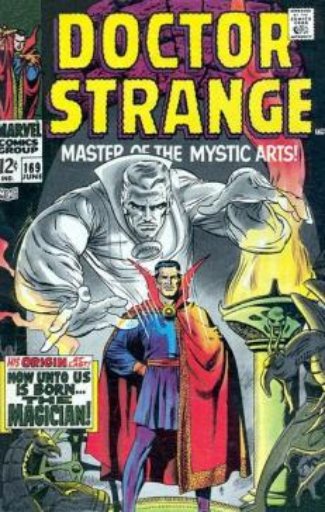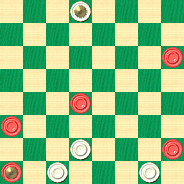Master of the Mystic Arts

We've written about Julius D'Orio before; his book, Mysteries of Dama, is as entertaining and unusual a checker book as can ever be found. Mr. D'Orio is indeed something of a "Dr. Strange" character, but is he a master of the mystic arts? Can checker lore be ascribed to such a domain?
We can't give a definitive answer to that question, but we can say that today's Checker School lesson, taken from Ben Boland's Famous Positions in the Game of Checkers, features the colorful Mr. D'Orio once again.
The problem position is indeed intriguing.
BLACK

WHITE
White to Play and Win
W:W32,30,26,K2:BK29,28,21,18,12.
White, a man down, can still win. But how? What is the mystical series of moves that allows White to defeat the odds and bring home a victory?
Incantations are not necessary, just solid over the board skills. Give it a try and then wave your magic mouse on Read More to see the solution, notes, and a very instructive sample game.
Solution
(Lettered notes and unattributed commentary are by Ben Boland. Numbered notes are by the Editor, using the KingsRow computer engine and 10-piece endgame database.)
White is already a man down, what to do?
26-22---1 18x25 2-7 12-16 7-11 16-19 32-27---2 28-32---B 11-16 32x23---3 30-26 23x30---4 16x23 30-26 23x30 White Wins.
Game: 11-16, 24-20, 16-19, 23-16, 12-19, 22-18, 9-14, 18-9, 5-14, 25-22, 10-15, 22-17, 6-10, 29-25, 8-11, 17-13, 4-8, 25-22, 2-6, 22-17, 19-24, 28-19, 15-24, 26-23, 24-28, 23-18, 14-23, 27-18, 10-15, 18-14, 15-18, 14-9, 6-10, 17-14, 10-17, 21-14, 18-22, 9-5, 7-10, 14-7, 3-10---5, 13-9, 10-14, 9-6---6, 1-10, 5-1, 14-17, 1-6---7, 17-21, 6-15, 11-18, 20-16, 8-12, 16-11, 22-25, 11-7, 25-29, 7-2, 29-25---A, 8, 31-26, 25-29. Forms above position. Hopewell (Fred Hogue) vs. D'Orio, see game No. 121, Third American Tourney Book, 1915.
A---21-25, 30-21, 18-22, 2-7, 12—16. Drawn. Third American Tourney Book.
B---19—23, 27-18, 28-32, 11-15, 32-27, 18-14, 27-23, 15-18, 23-26, 30-23, 25-30, 18-22, 30-25, 23-18, 25-30, 14-9, 30-25, 9-6, 25-30, 6-2, 30-25, 2-6, 25-30, 6-10, 30-25, 10-15, 25-30, 18-14, 30-25, 15-18, 25-30, 14-10, 30-25, 10-7, 25-30, 7-2, 30-25, 2-7, 25-30, 7-11, 30-25, 11-16, 25-30, 18-23, 30-25, 22-26, 25-30, 23-19. White Wins. Same as No. 560, by I. Hedley, Gould's Problem Book. Also turn to ending by W. Payne and H. Spayth.
1---Now White is two men down.
2---11-16 loses: 11-16 19-23 16-19 23-26 30x23 and Black frees up his position and wins.
3---Now White is three men down.
4---White goes four men down, just for a moment, but the win is in sight.
5---End of KingsRow opening book.
6---The computer here chooses 31-27, however the text move is fine, as the early king compensates for being a man down.
7---1-5 is a little better here.
8---Loses. The computer move is 18-22, after which black still has a small advantage, but not enough to win. The same is true for the move proposed at Note A.
The above position by Julius D’Orio, may be found in his “Mysteries of Dama," 1922, as Figures 49, 50 and 51. But in his Fig. 49 he has a King on 28 (colors reversed), and when 28-32 at B (above), is played, 28-24 instead draws.
You can email the Webmaster with comments on this article.